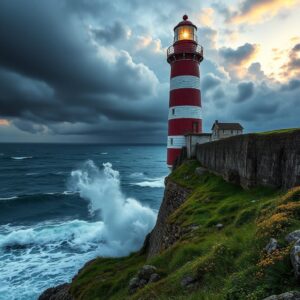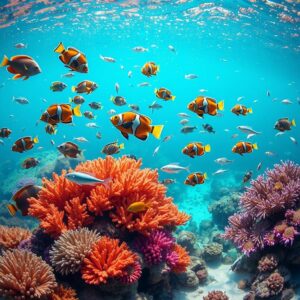
Explore & Play
Discover interesting topics and solve the accompanying crossword puzzle.
Sea Crossword | Explore the World’s Oceans and Seas
Crossword enthusiasts will enjoy our Sea crossword, exploring diverse bodies of water. Dive into our article for fascinating insights on global seas.
Table of Contents
Welcome to our blog post! Before diving into the fascinating world of seas, we invite you to try your hand at the Sea crossword. This engaging puzzle will test your knowledge and set the stage for what you’re about to learn. If you’re already familiar with the topic, feel free to tackle the crossword first for a fun challenge. However, if you’d like some background information, you can read through the article and then come back to the crossword to reinforce your understanding. Enjoy your exploration!
Sea Crossword
You can either fill in the crossword puzzle directly on this page or click the button in the bottom right corner to print it for free.

Exploring Earth's Oceans: A Journey Through World Beautiful Seas
The world’s seas are more than just vast bodies of water—they are gateways to history, biodiversity, and interconnected ecosystems. This article will take you on a journey through 50 of the most significant seas on Earth, from the well-known Mediterranean to the mysterious Amundsen Sea in Antarctica. As you explore, you’ll also encounter some of these seas in our crossword puzzle, allowing you to test your knowledge along the way.
1. The Mediterranean and Its Many Sub-Seas
Perhaps no sea has shaped history and culture as much as the Mediterranean, home to the Aegean, Ionian, Adriatic, and many others. The Mediterranean Sea, often referred to as the cradle of civilization, has served as a crossroads for trade, culture, and migration for millennia. Its warm waters and diverse marine life have made it a sought-after destination for travelers and traders alike.The Mediterranean Sea
The Mediterranean Sea spans three continents—Europe, Asia, and Africa—making it one of the most culturally rich bodies of water in the world. It boasts numerous islands, such as Sicily and Crete, which are steeped in mythology and history. The sea’s strategic position facilitated trade routes that connected ancient empires, allowing for the exchange of goods, ideas, and cultures.Aegean Sea
Nestled between Greece and Turkey, the Aegean Sea is known for its stunning islands and azure waters. This sea has deep ties to Greek mythology, with legends surrounding its islands and ancient ruins. From the tales of the Minotaur on Crete to the adventures of Odysseus, the Aegean Sea is a living testament to Greece’s rich history.Ionian Sea
The Ionian Sea lies to the west of Greece and is famous for its picturesque coastlines and vibrant blue waters. This sea has historically connected Italy and Greece, enabling cultural exchange and trade. Today, it remains a popular destination for tourists seeking sun, sea, and history.Adriatic Sea
The Adriatic Sea separates Italy from the Balkan Peninsula, offering stunning landscapes and historical significance. Its northern coast, home to Venice, is renowned for its canals and rich maritime heritage. The Adriatic has played a vital role in trade and cultural exchange for centuries, making it a key player in Mediterranean history.Tyrrhenian Sea
On the western coast of Italy, the Tyrrhenian Sea is known for its beautiful islands, including Elba and Capri. The sea is not only a popular tourist destination but also an important fishing ground. It has shaped the coastal cultures of Italy, offering a glimpse into the region’s maritime traditions.2. The Cold Northern Seas: A Glimpse Into the Arctic
While the warm Mediterranean draws visitors, the icy northern seas like the Barents, Kara, and Beaufort remain remote, mysterious, and vital to understanding our planet’s climate. These seas, located in the Arctic region, are crucial for studying climate change, as they are highly sensitive to temperature fluctuations and melting ice.Barents Sea
The Barents Sea, situated north of Norway and Russia, is a vital fishing ground known for its rich marine biodiversity. This sea is also experiencing significant changes due to climate change, with warmer temperatures affecting fish populations and ecosystems. As scientists study these changes, the Barents Sea becomes a focal point for understanding the future of Arctic marine environments.Kara Sea
The Kara Sea, located to the north of Siberia, is characterized by its ice-covered waters and harsh climate. Despite its challenging conditions, this sea is an essential area for oil exploration and shipping routes. With the Arctic ice melting, the Kara Sea is becoming increasingly accessible, raising concerns about environmental impacts and geopolitical tensions.Beaufort Sea
The Beaufort Sea lies north of Alaska and Canada, known for its stunning landscapes and rich marine life. This sea plays a critical role in polar exploration and climate research, as it provides insights into the effects of climate change on Arctic ecosystems. The Beaufort Sea’s unique environment makes it a key area for scientists studying the impacts of global warming.Norwegian Sea
The Norwegian Sea, part of the North Atlantic Ocean, is vital to Norway’s coastal culture. It is home to significant fishing industries and has been a crucial area for maritime activities. The Norwegian Sea is also famous for its stunning landscapes, including the dramatic fjords along Norway’s coast, attracting nature lovers and adventurers alike.3. The Pacific’s Tropical and Remote Waters
The Pacific Ocean is vast, and within it are seas like the Coral, Banda, and Celebes that are rich in marine biodiversity. These tropical waters are home to vibrant ecosystems, supporting countless species of marine life. As we explore these seas, we gain a deeper understanding of the importance of marine conservation.Coral Sea
The Coral Sea is famous for its breathtaking coral reefs, including the Great Barrier Reef, one of the most diverse ecosystems on the planet. This sea is a paradise for divers and marine enthusiasts, offering a unique glimpse into underwater life. However, it also faces threats from climate change, pollution, and overfishing, making conservation efforts critical to preserving its beauty and biodiversity.Banda Sea
Located in Indonesia, the Banda Sea is known for its incredible biodiversity and rich marine resources. This sea is part of the Coral Triangle, which is often referred to as the global center of marine biodiversity. The Banda Sea’s unique ecosystems provide habitats for numerous species, making it essential for ecological balance and conservation efforts.Celebes Sea
The Celebes Sea, bordered by the Philippines and Indonesia, is another rich marine environment. Its deep waters and diverse habitats support a variety of marine species, making it a popular destination for diving and snorkeling. As marine tourism grows, there is a pressing need to balance environmental protection with economic development in this region.Philippine Sea
The Philippine Sea, located east of the Philippines, is a significant area for marine biodiversity. This sea has been a focal point for marine research, as scientists study its unique ecosystems and the impacts of climate change. The Philippine Sea also played a crucial role in World War II naval history, marking a significant chapter in military strategy.Bismarck Sea
The Bismarck Sea, situated north of Papua New Guinea, is known for its strategic importance during World War II. Today, it remains an area of interest for marine research and conservation efforts. The sea’s diverse ecosystems are home to unique species, making it a vital area for preserving marine life.4. The Seas that Connect Asia and the Middle East
From the Arabian Sea to the Sea of Japan, these waters have been key to both ancient trade routes and modern geopolitical tensions. As vital waterways, they connect nations and cultures, fostering trade and communication while also presenting challenges in terms of territorial disputes and environmental concerns.Arabian Sea
The Arabian Sea, located between the Arabian Peninsula and India, has been a significant maritime route for centuries. This sea facilitates trade between the Middle East, Africa, and South Asia, making it a crucial economic hub. Its warm waters and rich marine life also contribute to the region’s fishing industries.Red Sea
The Red Sea, bordered by Egypt, Sudan, Saudi Arabia, and Yemen, is known for its stunning coral reefs and historical significance. This sea is a vital shipping route, connecting the Mediterranean Sea to the Indian Ocean via the Suez Canal. The Red Sea’s unique marine ecosystems make it a hotspot for biodiversity and conservation efforts.Sea of Japan
The Sea of Japan, situated between Japan, Korea, and Russia, has profound geopolitical significance. This sea has been a focal point for maritime disputes, particularly between Japan and its neighbors. Beyond politics, the Sea of Japan is rich in marine resources, supporting fishing industries and unique ecosystems.East China Sea
The East China Sea, located between China, Taiwan, and Japan, is known for its complex geopolitical landscape. This sea is a critical maritime route for trade and has been a source of tension due to territorial disputes. Despite these challenges, the East China Sea is rich in marine life, making it an area of interest for researchers and conservationists.South China Sea
The South China Sea is one of the most contested waters globally, with various countries asserting claims over its islands and resources. This sea is crucial for international shipping routes, with a significant percentage of global trade passing through it. The South China Sea’s rich marine ecosystems also face threats from overfishing and habitat destruction, highlighting the need for conservation efforts.5. The Lesser-Known Seas of the World
While some seas are famous, others like the Chukchi, Ross, and Amundsen are less known but equally important to the scientific community. These seas offer insights into Earth’s climatic history and are vital for ongoing research into climate change and marine ecosystems.Amundsen Sea
The Amundsen Sea, located off the coast of Antarctica, is significant for climate research. Scientists study this sea to understand the effects of global warming on polar ice melt and its implications for global sea levels. The Amundsen Sea’s unique environment makes it a critical area for ongoing research.Ross Sea
The Ross Sea is known for its pristine environment and rich biodiversity. This sea has been designated a marine protected area, emphasizing the importance of conservation in the face of climate change. The Ross Sea’s unique ecosystems provide habitats for various species, making it a vital area for ecological balance.Chukchi Sea
The Chukchi Sea, situated between Alaska and Siberia, is essential for Arctic research. This sea’s ice-covered waters are home to unique marine species and play a crucial role in climate regulation. The Chukchi Sea’s importance extends beyond its ecosystems, as it is a key area for understanding the impacts of climate change on Arctic environments.East Siberian Sea
The East Siberian Sea, located north of Russia, is characterized by its ice-covered waters and remote location. This sea is critical for studying the impacts of climate change, as it experiences rapid warming and ice melt. The East Siberian Sea’s unique environment offers valuable insights into the future of Arctic marine ecosystems.6. The Dynamic Seas of Europe
Europe is surrounded by seas that have played pivotal roles in shaping its geography and culture, including the Baltic, Celtic, and North Seas. These waters are essential for trade, transportation, and cultural exchange, highlighting the interconnectedness of European nations.Baltic Sea
The Baltic Sea is bordered by several countries, including Sweden, Finland, and Poland. This sea has historically been a crucial trade route, connecting Northern Europe and facilitating cultural exchange. The Baltic Sea’s unique ecosystems are home to various species, making it a focal point for conservation efforts.Celtic Sea
The Celtic Sea lies off the southern coast of Ireland, known for its stunning landscapes and rich maritime culture. This sea has played a significant role in the history of Ireland and the British Isles, serving as a vital shipping route for centuries. The Celtic Sea’s unique environment supports diverse marine life, making it an area of interest for researchers.North Sea
The North Sea is an important area for trade and energy production, bordered by countries like the UK, Norway, and the Netherlands. This sea is rich in oil and gas reserves, making it a critical economic hub for Europe. The North Sea also supports significant fishing industries, contributing to the livelihoods of many coastal communities.Irish Sea
The Irish Sea separates Ireland from Great Britain, serving as a vital maritime route for trade and transportation. This sea has a rich maritime history and is known for its stunning coastal landscapes. The Irish Sea’s diverse ecosystems support various marine species, emphasizing the importance of conservation in this region.7. The African and American Seas: Cultural and Economic Lifelines
From the Gulf of Guinea to the Gulf of Mexico, these seas are economic hubs and cultural intersections for many nations. They play a crucial role in facilitating trade, supporting fisheries, and providing resources essential for the livelihoods of coastal communities.Gulf of Guinea
The Gulf of Guinea, located along the west coast of Africa, is a vital area for trade and fishing. This sea supports numerous fishing industries, providing livelihoods for many coastal communities. Additionally, the Gulf of Guinea is rich in oil reserves, contributing to the region’s economic development.Gulf of Mexico
The Gulf of Mexico is known for its warm waters and rich biodiversity. This sea plays a significant role in energy production, with numerous oil rigs operating in its waters. The Gulf of Mexico’s diverse ecosystems support various marine species, making it a critical area for conservation efforts.Caribbean Sea
The Caribbean Sea is famous for its tropical islands and vibrant marine life. This sea is a popular tourist destination, attracting millions of visitors each year. The Caribbean Sea’s unique ecosystems support diverse marine species, emphasizing the importance of protecting these fragile environments.Gulf of California
The Gulf of California, located between the Baja California Peninsula and mainland Mexico, is renowned for its rich marine biodiversity. This sea is home to numerous species, including the endangered vaquita porpoise. The Gulf of California’s unique ecosystems provide critical habitats for marine life, making it an area of interest for conservationists.8. The Frozen and Forgotten: A Dive into the Coldest Seas
While warm seas dominate tourism brochures, the icy waters of the Labrador, Laptev, and Okhotsk seas hold secrets to Earth’s past climate. These seas are crucial for understanding climate patterns and the effects of global warming on polar regions.Labrador Sea
The Labrador Sea, located between Greenland and Canada, is known for its cold waters and icebergs. This sea plays a significant role in global climate regulation, influencing ocean currents and weather patterns. The Labrador Sea’s unique environment provides valuable insights into the impacts of climate change on polar regions.Laptev Sea
The Laptev Sea, situated north of Siberia, is characterized by its ice-covered waters and harsh climate. This sea is essential for studying the effects of climate change, as it experiences rapid warming and ice melt. The Laptev Sea’s unique environment offers valuable insights into the future of Arctic marine ecosystems.Okhotsk Sea
The Okhotsk Sea, located off the eastern coast of Russia, is known for its rich marine resources. This sea supports significant fishing industries and plays a critical role in the region’s economy. The Okhotsk Sea’s unique ecosystems provide habitats for various species, highlighting the importance of conservation in this region.9. Seas That Define Island Nations
For island nations like Japan and the Philippines, seas like the Sea of Japan and the Philippine Sea define their existence. These waters play crucial roles in shaping their cultures, economies, and maritime traditions.Sea of Azov
The Sea of Azov, located to the north of the Black Sea, is known for its shallow waters and rich fishing grounds. This sea has played a significant role in the history of Eastern Europe, serving as a crucial trade route. The Sea of Azov’s unique environment supports various marine species, emphasizing the importance of conservation in this region.Java Sea
The Java Sea, situated between the islands of Java and Borneo, is known for its rich marine resources. This sea plays a vital role in supporting the fishing industries of Indonesia. The Java Sea’s unique ecosystems provide critical habitats for marine life, making it an area of interest for researchers and conservationists.Liguria Sea
The Liguria Sea, part of the Mediterranean, is known for its stunning coastal landscapes and rich maritime culture. This sea has played a significant role in the history of Italy, particularly along the Italian Riviera. The Liguria Sea’s diverse ecosystems support various marine species, highlighting the importance of conservation in this region.Marmara Sea
The Marmara Sea, located between Europe and Asia, connects the Black Sea to the Mediterranean. This sea is crucial for trade and transportation, serving as a vital shipping route for many nations. The Marmara Sea’s unique environment supports diverse marine life, making it an area of interest for conservation efforts.10. Seas and Their Role in Global Climate Systems
Seas like the Tasman, Yellow, and East China play significant roles in regulating weather patterns and ocean currents. These waters are critical for understanding climate systems and the impacts of climate change on marine ecosystems.Tasman Sea
The Tasman Sea, located between Australia and New Zealand, is known for its stunning landscapes and rich marine biodiversity. This sea plays a significant role in influencing ocean currents and weather patterns in the region. The Tasman Sea’s unique ecosystems provide habitats for various species, highlighting the importance of conservation efforts.Yellow Sea
The Yellow Sea, bordered by China and Korea, is known for its tidal flats and rich marine resources. This sea plays a critical role in supporting the fishing industries of both countries. The Yellow Sea’s unique environment provides critical habitats for various marine species, making it an area of interest for researchers and conservationists.East China Sea
The East China Sea is significant for regional climate systems and maritime trade. This sea is known for its complex geopolitical landscape, with various countries asserting claims over its resources. Despite these challenges, the East China Sea is rich in marine life, emphasizing the need for conservation efforts in this region.The Vast Ocean of Knowledge Awaits
As we journey across the seas, we see their immense variety and importance, from history to climate and ecosystems. Now that you’ve explored these fascinating bodies of water, take a moment to challenge yourself by solving our crossword puzzle, where you can test your memory on these global waters. Dive in and enjoy the adventure!Share to...
Thank you for reading 👋
I hope you enjoy the content.
I hope you enjoy the content.
Want to receive our daily crossword puzzle or article? Subscribe!
You may also be interested in
Share to…
Want to receive our daily crossword puzzle?
“True Crime Activity Book: 50 Cases 100 Puzzles | Serial Killer | Cyber Crime | Code Case” has been added to your basket. View basket
-
Jigsaw Puzzles
Fish Market in Norway Jigsaw Puzzle 250 | 300 | 500 Pieces
kr 348,00 – kr 439,00 Select options This product has multiple variants. The options may be chosen on the product page -
Jigsaw Puzzles
Autumn Whiskers and Pumpkin Paws Puzzle 250 | 300 | 500 Pieces
kr 348,00 – kr 439,00 Select options This product has multiple variants. The options may be chosen on the product page -
Jigsaw Puzzles
Lofoten Serenity: Abstract Puzzle 250 | 300 | 500 Pieces
kr 348,00 – kr 439,00 Select options This product has multiple variants. The options may be chosen on the product page

















